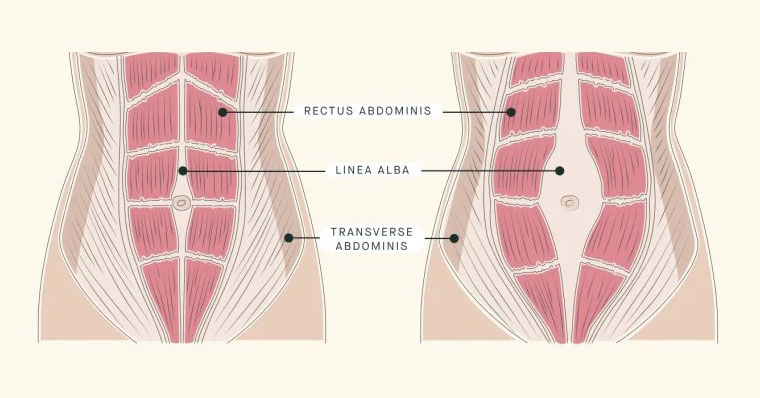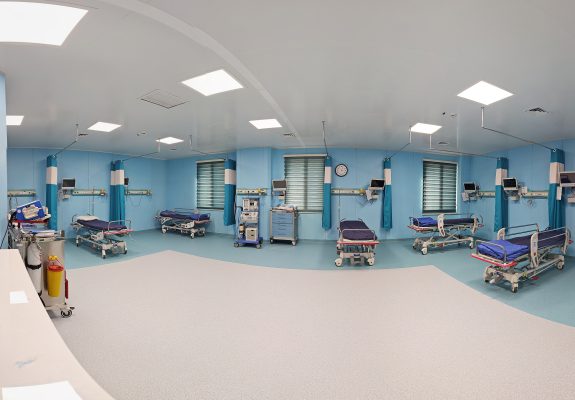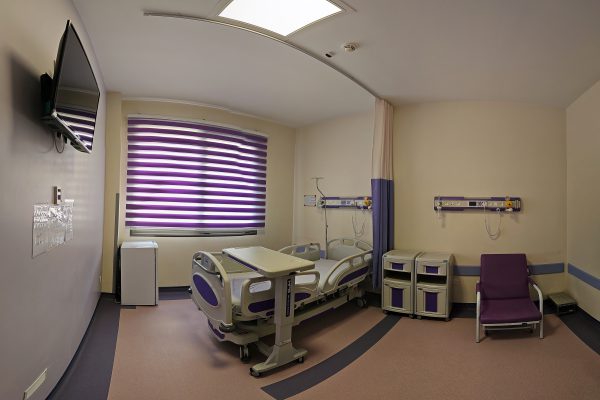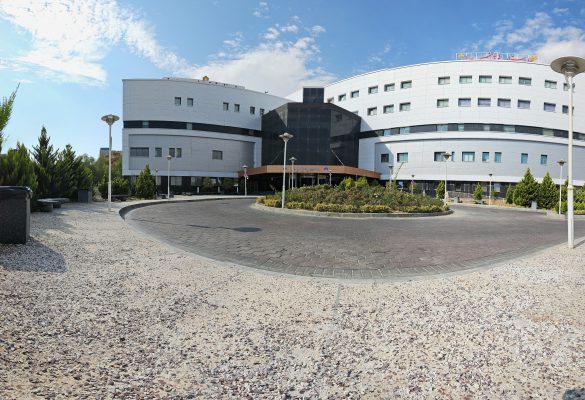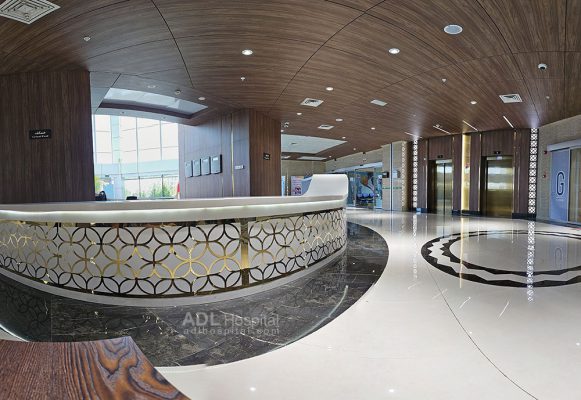Tummy Tuck in Iran (Abdominoplasty)
A tummy tuck in Iran , medically known as abdominoplasty, is a cosmetic surgical procedure that removes excess fat and skin and, in most cases, restores weakened or separated muscles creating an abdominal profile that is smoother and firmer.
Procedure – Abdominoplasty in Iran
The procedure is performed under general anesthesia. The surgeon makes a horizontal incision in the area between the pubic hairline and belly button. The shape and length of the incision will be determined by the amount of excess skin. Once the abdominal skin is lifted, the underlying weakened abdominal muscles are repaired. A second incision around the navel may be necessary to remove excess skin in the upper abdomen.
The upper abdominal skin is pulled down like a window shade. The excess skin is trimmed and the remaining skin is sutured together. A new opening for the belly button is created. The belly button is popped through to the surface and sutured into position.

Benefits
1. Improved abdominal tone and better posture: A tummy tuck can actually help improve the look and feel of your abdomen.
2. Excess skin removal after significant weight loss: For individuals who have lost a lot of weight, a tummy tuck can help get rid of stubborn excess skin.
3. Ventral hernia correction: A tummy tuck can correct a ventral hernia, a type of hernia that occurs in the abdominal wall.
If you want to operate in Tehran Adl Hospital, click the button below and follow the steps
Cost of Tummy Tuck in Iran
The cost of abdominoplasty surgery in Iran depends on the following factors
Surgeon’s salary
Surgeons with more experience usually get paid more
The cost of a hospital or surgery clinic
Depending on the equipment and facilities of the hospital, you will have a different cost
Health status of the applicant
If you have an underlying disease, special care may be required and the cost will increase
Abdominoplasty repair surgery
If you have already had abdomen surgery, the surgery may be more difficult and more expensive
Usually 10 days stay is enough for abdominoplasty surgery in Iran
The cost of hotel and accommodation will be added to your expenses
Other costs of abdominoplasty surgery in Iran
- Cost of blood test (about 10 to 15 euros)
- The cost of special garment after surgery (about 60 to 90 euros)
- The cost of heart consultation (if you are over 40 years old or have a heart problem, you need to consult a cardiologist) The
- cost of heart consultation is about 35 euros)
- The cost of massage after surgery (usually 2 massage sessions are recommended), the price of each session is 20 euros
Usually, the cost of abdominoplasty and liposuction of the abdomen, back and sides in Iran (including surgeon and hospital fees) is between 2,500 and 3,500 euros.
The cost of abdominoplasty and liposuction of the abdomen, back and sides in Adl Hospital is 2700 euros.
The cost of mini abdominoplasty will be lower
The cost of abdominoplasty with T-shaped incision and tummy tuck belt or body lift will be more
Risks
As with any major surgery, a tummy tuck poses potential health risks. These may include:
1. Anesthesia risks
2. Bleeding
3. Infection
4. Fluid accumulation (seroma)
5. Poor wound healing
6. Skin loss
7. Blood clots
8. Numbness or other changes in skin sensation
9. Persistent pain
Recovery
Recovery times can vary depending on the individual and the extent of the surgery. It’s important to follow your doctor’s instructions to ensure a smooth recovery and avoid complications. This may include instructions on how to care for the surgical site, medications to apply or take orally, and when to follow up with your surgeon.
Always consult with a qualified healthcare provider before deciding to proceed with any surgical procedure. They can provide you with detailed information about what to expect and determine whether you’re a good candidate for a tummy tuck in Iran .
What reason for tummy tuck in Iran
A tummy tuck in Iran , or abdominoplasty, is typically performed for cosmetic reasons, often after significant weight loss or pregnancy. Here are some common reasons why people might consider getting a tummy tuck:
1. Excess fat and skin after weight loss: After significant weight loss, the skin often doesn’t tighten completely, which can lead to excess, sagging skin around the abdomen. A tummy tuck can remove this excess skin and fat, helping to improve the appearance of the abdomen.
2. Post-pregnancy changes: Pregnancy can stretch the skin and muscles in the abdomen, sometimes to a point where they cannot return to their original form. A tummy tuck in Iran can help restore the appearance of the abdomen by tightening the skin and repairing the abdominal muscles.
3. Aging: As people age, the skin naturally loses some of its elasticity, which can lead to sagging. This is particularly common in the abdominal area. A tummy tuck can help to mitigate these effects and provide a more youthful appearance.
4. Hernia repair: In some cases, a tummy tuck may be performed to repair a ventral hernia. This type of hernia can form in the abdominal wall muscles due to surgery, obesity, or C-sections. A tummy tuck can strengthen the abdominal wall and prevent future hernias from occurring.
5. Improved self-esteem: For many people, having excess skin or fat in the abdomen can lead to feelings of self-consciousness or unhappiness with their appearance. A tummy tuck in Iran can help to improve this, leading to increased self-confidence.
6. Ineffectiveness of diet and exercise: Sometimes, despite regular exercise and a healthy diet, individuals may struggle to lose weight and tighten the skin in the belly area. In such cases, a tummy tuck might be considered.
How prepare for tummy tuck in Iran
Preparing for a tummy tuck, or abdominoplasty, involves several steps. Your surgeon will guide you through the process, but here are some general guidelines to consider:
1. Medical Evaluation: You may need to get lab testing or a medical evaluation done to ensure you’re in good health before the surgery. These tests can help identify any potential complications that might arise during surgery.
2. Quit Smoking: If you smoke, you’ll need to stop at least two weeks before the surgery. Smoking can increase your risk of complications and slow down the healing process.
3. Avoid Certain Medications: Some medications and herbal supplements can increase the risk of bleeding. Your doctor will likely advise you to avoid taking aspirin, anti-inflammatory drugs, and certain herbal supplements before the surgery.
4. Maintain a Healthy Weight: If you’re planning to lose a significant amount of weight, it’s usually best to achieve this before your surgery. Significant fluctuations in weight following a tummy tuck can affect the surgery’s outcome.
5. Arrange for Help Post-Surgery: You’ll need someone to drive you to and from the surgery, and you may also need someone to stay with you for at least the first night following the surgery.
6. Prepare Your Home for Recovery: Have ice packs (to reduce swelling), petroleum jelly (for incision sites), loose and comfortable clothing that can be put on and taken off easily, and a handheld shower head and bathroom chair available.
7. Follow Preoperative Instructions: Your surgeon will give you instructions about what you should do on the day of your surgery. This may include guidelines on when you should stop eating or drinking, and what medications you should take..
More on Preparing for the abdominoplasty in Iran
– Physical Health: It’s essential to be in the best possible physical health before your procedure. This includes eating a balanced diet and engaging in regular exercise. Good nutrition can help enhance your body’s ability to heal itself.
– Mental Health: It’s also important to have a positive mindset and realistic expectations about the outcome of the surgery. You may want to consider speaking with a therapist or counselor to mentally prepare yourself for the changes your body will go through.
– Inform Your Surgeon of All Medications: Make sure your surgeon knows about all the medication you are taking. This includes over-the-counter drugs and supplements. Some medications can interact with anesthesia or increase the risk of bleeding.
– Prepare for Post-Surgery: Make sure you have all the supplies you might need during recovery, like gauze, comfortable clothes, and foods that are easy to prepare and eat. Also, ensure your recovery area is set up for comfort and convenience.
Recovery Process for tummy tuck in Iran
– Immediately After Surgery:
When you wake up after surgery, you’ll likely feel groggy from the anesthesia. You’ll have bandages applied to your incision sites, and you may have drains to prevent fluid buildup.
– First Few Days:
You’ll experience some swelling and discomfort, which can be controlled with prescribed pain medication. It’s important to get up and walk (with assistance) as soon as possible to aid circulation and prevent blood clots.
– Longer-Term Recovery:
Over time, you’ll gradually regain normal function and be able to do more activities. However, heavy lifting and strenuous exercise should be avoided until your doctor gives you the all-clear.
– Follow-up Appointments:
You’ll have follow-up appointments with your surgeon to monitor your progress. It’s crucial to attend these appointments and follow your surgeon’s advice to ensure a smooth recovery.
– Scarring:
Scarring is a normal part of the healing process after a tummy tuck. Over time the scar will fade, but it won’t disappear completely. Your surgeon can advise on scar care to promote healing and minimize the scar’s appearance.
Remember, everyone’s body reacts differently, and recovery times can vary. Always follow your healthcare provider’s advice and guidelines for both preparation and recovery.
What you can expect for tummy tuck in Iran
A tummy tuck, also known as abdominoplasty, is a surgical procedure that can significantly reshape the abdomen. Here’s what you can typically expect before, during, and after the procedure:
Before the tummy tuck in Iran
Consultation:
You’ll meet with your surgeon to discuss your goals, medical history, and the procedure in detail. This will include the benefits, risks, and pre- and post-operative care. Your surgeon will likely conduct a physical exam, take photographs, and discuss what approach will best meet your goals.
Preparation:
You will need to prepare for the surgery as mentioned in the previous posts. This includes getting a medical evaluation, stopping smoking, avoiding certain medications, maintaining a healthy weight, arranging for help post-surgery, and following any preoperative instructions from your surgeon.
During the tummy tuck in Iran
Anesthesia: Tummy tucks are typically performed under general anesthesia. You’ll be asleep during the procedure and won’t feel any pain.
Incisions: The surgeon will make one or more incisions to remove excess skin and fat and to tighten your abdominal muscles. The incisions can vary in size depending on the extent of the surgery and your body’s characteristics.
Closing the Incisions: Once the desired alterations have been made, the surgeon will close the incisions with sutures. They may place temporary tubes under your skin to drain any excess fluid or blood that may collect.
After the tummy tuck in Iran
Recovery Room: Immediately after the surgery, you’ll be taken to a recovery room where medical staff will monitor you as you wake up from the anesthesia.
Pain Management: You’ll likely experience some pain and swelling in the days following the surgery. Your doctor can prescribe medication to manage the pain.
At Home: Once you’re home, it’s important to follow your doctor’s instructions on how to care for your incisions and drains, what medications to take, how to position yourself while sitting or lying down, and what level of activity is safe.
Follow-Up Visits: You’ll need to see your doctor for follow-up appointments to monitor your progress and remove stitches and drains. This is also an opportunity to discuss any concerns you might have.
Expected Results: After the swelling has decreased and the incisions have healed, you’ll be able to see the results of your tummy tuck. This should be a flatter, firmer abdominal contour that is more proportionate with your body type and weight. Do note that it may take several weeks or even months for the final result to become apparent.
A tummy tuck is a significant procedure, and it’s important to have realistic expectations about the recovery time and the results. It’s not a substitute for weight loss or an appropriate fitness program, and the positive results can be greatly diminished by significant fluctuations in your weight after the surgery. Always consult with your healthcare provider to know what to expect based on your specific circumstances.
Type of abdominoplasty
Abdominoplasty, commonly known as a tummy tuck, is a surgical procedure that improves the appearance of the abdomen by removing excess skin and fat and tightening the abdominal muscles. There are several types of abdominoplasty, each designed to address different patient needs. Here are the most common types:
1. Full (or “Classic”) Abdominoplasty:
This is the most common type of tummy tuck. It involves an incision across the lower abdomen (from hip bone to hip bone) and around the navel. The surgeon removes excess skin, tightens the abdominal muscles, and then repositions the navel. This procedure is suitable for individuals who need the most correction.
2. Mini (or “Partial”) Abdominoplasty:
This procedure is designed for those who have fat deposits located below the navel. The surgeon makes a smaller incision and may not need to reposition the navel. The recovery time is often shorter for this procedure compared to a full abdominoplasty.
3. Extended Abdominoplasty:
This is a full abdominoplasty plus a lateral thigh lift. The operation does all the abdominal work of a complete abdominoplasty and also improves the waist and upper lateral thigh.
4. Circumferential Abdominoplasty:
Also known as a body lift, this procedure is often performed on patients who have undergone massive weight loss. It involves an incision extending around the circumference of the body, through which the surgeon can remove excess skin and fat from the abdomen and back.
5. Fleur-de-Lis Abdominoplasty:
This type of tummy tuck is often performed on patients who have lost significant amounts of weight and have excess skin in both the vertical and horizontal dimensions. It includes a vertically oriented incision down the middle of the abdomen in addition to the standard horizontal incision, creating a fleur-de-lis pattern.
6. Reverse Abdominoplasty:
In this less common procedure, the incision is made along the underside of the breasts, rather than near the bikini line. It’s typically recommended for patients with excess skin in the upper abdomen.
Each of these procedures has its own advantages, risks, and recovery times. The best type of abdominoplasty for any given patient depends on their individual circumstances, including their health status, aesthetic goals, and the amount and location of their excess skin and fat. It’s important to discuss these factors in depth with a qualified plastic surgeon to determine the best approach.
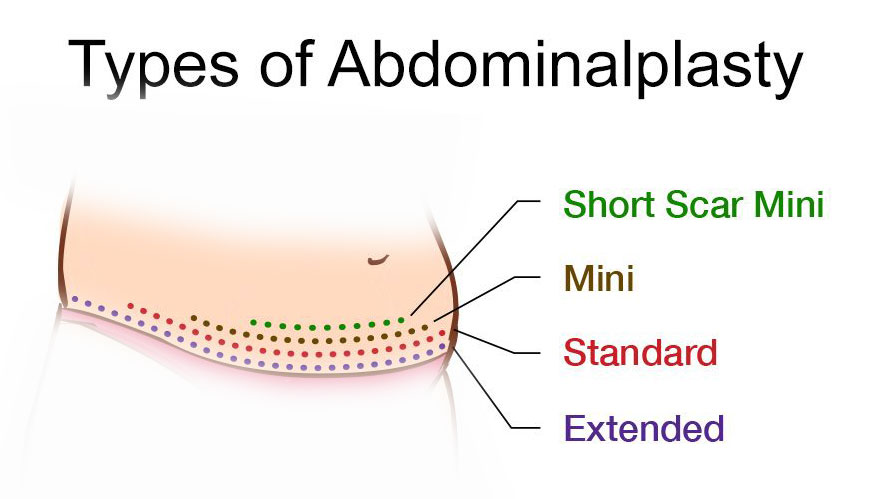
Type of abdominoplasty incisions
The type of incision made during an abdominoplasty (tummy tuck) largely depends on the specific type of tummy tuck being performed. Here are the usual incisions associated with various types of abdominoplasty:
1. Full (or “Classic”) Abdominoplasty:
This procedure typically involves two incisions. The first is a horizontal or slightly curved incision made from hip to hip, just above the pubic area. The second incision is made around the navel to free it from surrounding tissue. The skin is then separated from the abdominal wall up to the ribs, allowing the surgeon to tighten the underlying muscles and remove excess skin.
2. Mini (or “Partial”) Abdominoplasty:
This procedure generally involves a smaller, horizontal incision in the lower abdomen (below the navel and just above the pubic area). The size of the incision is similar to that of a C-section. As the changes are generally below the navel, there’s usually no need to create a second incision around the navel.
3. Extended Abdominoplasty:
The incisions for an extended abdominoplasty are similar to those in a full abdominoplasty, but they extend around the hips to the back. This allows for greater removal of skin and fat from the sides or “flanks” of the abdomen.
4. Circumferential (or Belt Lipectomy) Abdominoplasty:
This procedure involves an incision that goes all the way around the body, similar to the line of a belt. This procedure is often used for patients who have undergone significant weight loss and have substantial excess skin around their entire body.
5. Fleur-de-Lis Abdominoplasty:
This procedure involves a vertical incision from the lower sternum to the pubic area in addition to the usual horizontal incision. This allows for removal of excess skin in both vertical and horizontal dimensions, and is often used for patients who have undergone significant weight loss.
6. Reverse Abdominoplasty:
This involves an incision made along the underside of the breasts. This procedure is less common and is generally used for patients with excess skin in the upper abdomen.
The exact nature and location of the incisions depend on the extent of the surgery and the patient’s individual circumstances. Though the surgeon will endeavor to place incisions in locations that can be hidden by clothing, some scarring is inevitable. Over time, these scars can diminish and fade, but they won’t completely disappear. The ability to heal and the appearance of scars can vary widely among individuals. Always discuss this aspect with your surgeon prior to the procedure.


